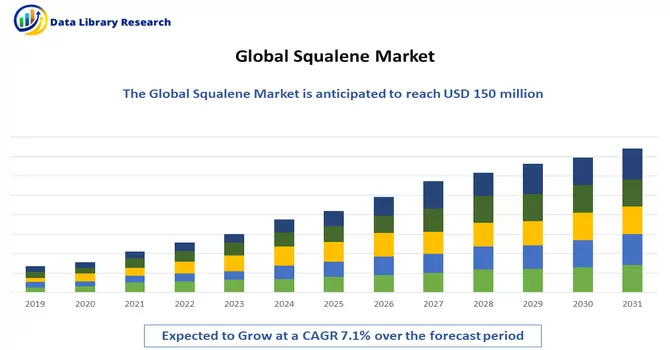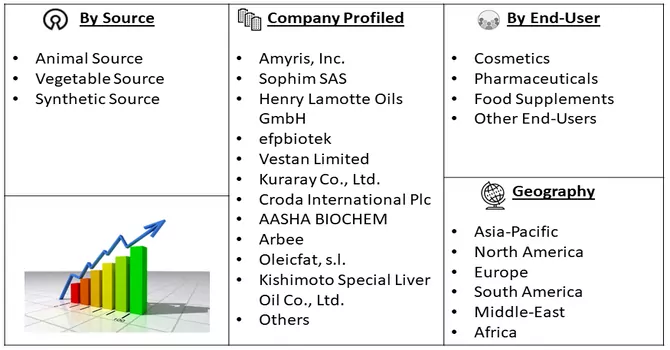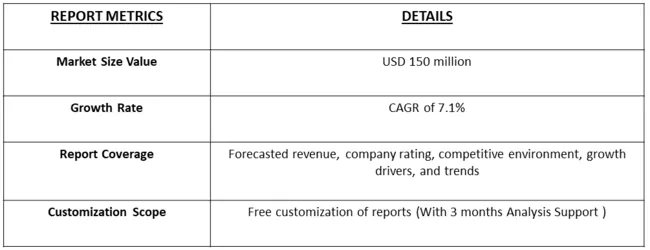The global squalene market size was valued at USD 150 million in 2023 and is projected to register a CAGR of 7.1%, over the forecast period, 2024-2031.

Get Complete Analysis Of The Report - Download Free Sample PDF
The global squalene market is witnessing robust growth, driven by increasing demand in diverse industries such as cosmetics, pharmaceuticals, and food supplements. Squalene, a natural compound sourced from shark liver, olive oil, and amaranth seed, is gaining prominence for its versatile applications. The cosmetic industry, in particular, is a major contributor to market expansion, with squalene being valued for its moisturizing and anti-ageing properties. Additionally, the pharmaceutical sector is utilizing squalene in vaccine formulations, further propelling market growth.
As consumer preferences shift towards natural and sustainable ingredients, manufacturers are exploring alternative, plant-based sources for squalene, fostering innovation in the market. Amidst these trends, the global squalene market is poised for continuous expansion, with opportunities for both established players and new entrants to capitalize on evolving market dynamics.One of the key growth driving factors for the global squalene market is the increasing consumer inclination towards natural and sustainable ingredients in various industries, such as cosmetics, pharmaceuticals, and dietary supplements. As awareness of the environmental impact and ethical concerns associated with traditional shark liver-derived squalene rises, there is a notable shift towards plant-based alternatives, including olive oil and amaranth seed, fostering innovation and expanding the market. This transition aligns with changing consumer preferences, propelling the demand for squalene derived from non-animal sources and creating opportunities for market players to meet the growing demand for eco-friendly and cruelty-free products.
Market Segmentation: The Global Squalene Market is Segmented by Source (Animal Source (Shark Liver, etc.), Vegetable Source (Olive Oil, Amaranth Seed, etc.) and Synthetic Source), End-Use Industry (Cosmetics, Pharmaceuticals, Food Supplements and Other End-Users), and Geography (Asia-Pacific, North America, Europe, South America, and Middle East and Africa). The report offers market size and forecasts for pyrolysis oil in terms of revenue in USD million for all the above-mentioned segments.

For Detailed Market Segmentation - Download Free Sample PDF
The global squalene market is witnessing several notable trends that are shaping its trajectory. A prominent trend is the growing emphasis on sustainability and ethical sourcing, prompting manufacturers to explore and invest in plant-based alternatives to traditional shark liver-derived squalene. As consumers increasingly prioritize natural and eco-friendly products, the market is experiencing a surge in demand for squalene derived from sources like olive oil and amaranth seed. Additionally, the cosmetic industry's relentless pursuit of innovative formulations is driving the incorporation of squalene for its skin-rejuvenating and moisturizing properties. The pharmaceutical sector is also contributing to market growth, with squalene finding application in vaccine development. Moreover, advancements in extraction technologies and research into novel sources are further diversifying the market landscape, indicating a dynamic and evolving future for the global squalene market.
Market Drivers:
The rising demand in the cosmetics industry
The cosmetics industry is currently experiencing a surge in the demand for squalene, propelling its significance as a sought-after ingredient. Squalene, renowned for its natural moisturizing properties and anti-ageing benefits, has become a pivotal component in various skincare and beauty products. With consumers increasingly gravitating towards clean and natural formulations, cosmetic manufacturers are incorporating squalene into their products to meet the growing preference for sustainable and skin-friendly solutions. The rising awareness about the environmental impact and ethical considerations associated with traditional sources has also prompted a shift towards plant-based alternatives like olive oil and amaranth seed-derived squalene. This escalating demand within the cosmetics sector underscores Squalene's pivotal role in shaping contemporary beauty formulations and driving innovation in the ever-evolving landscape of personal care products.
The increasing utilization of squalene in pharmaceutical applications
The pharmaceutical industry is witnessing a noteworthy surge in the utilization of squalene, marking its pivotal role in vaccine development and other pharmaceutical applications. Squalene serves as a crucial adjuvant in vaccine formulations, enhancing their efficacy by stimulating a robust immune response. As the global focus on vaccine research and development intensifies, driven by infectious disease threats, the demand for squalene has risen significantly. Beyond vaccines, pharmaceutical companies are exploring squalene for its potential therapeutic benefits, signalling a diversification of its applications in the healthcare sector. The versatile properties of squalene make it a valuable ingredient, contributing to advancements in drug delivery systems and underscoring its growing importance in pharmaceutical innovations.
Market Restraints:
Despite the promising growth, the global squalene market faces certain restraints that impact its trajectory. One notable challenge is the ethical and environmental concerns associated with traditional shark liver-derived squalene, leading to a shift towards more sustainable, plant-based sources. However, this transition poses technological and economic challenges in achieving large-scale production and maintaining cost competitiveness. Additionally, fluctuations in raw material availability and prices for alternative sources like olive oil can pose challenges to market stability. Regulatory complexities and varying quality standards across regions also present obstacles for market players, affecting the seamless global distribution of squalene-based products. Navigating these hurdles requires industry stakeholders to invest in research and development, sustainable sourcing practices, and collaborative efforts to address environmental and ethical considerations while ensuring a stable and resilient global squalene market.
Segmental Analysis:
Animal Source (Shark Liver, etc.) Segment is Expected to Witness Significant Growth Over the Forecast Period
The extraction of squalene from animal sources, particularly shark liver, is experiencing significant growth driven by the expanding cosmetics and pharmaceutical industries. With a rise in consumer demand for natural and sustainable ingredients, squalene derived from shark liver is valued for its high purity and effectiveness in skincare products. However, concerns over environmental sustainability and animal welfare have led to efforts to find alternative sources such as vegetable oils. Despite these challenges, the market for animal-derived squalene continues to grow, supported by its unique properties and diverse applications in various industries.
Pharmaceuticals Segment is Expected to Witness Significant Growth Over the Forecast Period
Squalene's role in pharmaceuticals is expanding due to its numerous beneficial properties. It is widely used as an adjuvant in vaccines to enhance immune response, improve vaccine efficacy, and reduce the amount of antigen required per dose. Additionally, squalene is being investigated for its potential therapeutic applications in cancer treatment, as it has shown promising results in reducing tumour growth and enhancing the effectiveness of certain chemotherapy drugs. These factors are driving the demand for squalene in the pharmaceutical industry, positioning it as a valuable ingredient in the development of innovative medical treatments.
North America Region is Expected to Witness Significant Growth Over the Forecast Period
North America is experiencing a growing demand for squalene, driven by its increasing use in various industries. In the cosmetics sector, squalene is valued for its moisturizing and anti-ageing properties, leading to its incorporation into a wide range of skincare products. Additionally, the pharmaceutical industry in North America is recognizing squalene's potential as an adjuvant in vaccines and as a therapeutic agent in cancer treatment, further fueling its demand. Moreover, the region's focus on sustainability and natural ingredients is encouraging the exploration of squalene from renewable vegetable sources, contributing to its popularity in the market.
The global squalene market has experienced notable impacts from the COVID-19 pandemic, with disruptions across various segments. The cosmetic industry, a significant consumer of squalene, faced production slowdowns and supply chain interruptions, resulting in decreased demand. Travel restrictions and economic uncertainties during the pandemic further influenced consumer spending patterns, affecting the overall market dynamics. Additionally, the pharmaceutical sector, while witnessing increased demand for vaccine development, faced challenges in raw material sourcing and manufacturing due to pandemic-induced disruptions. Despite these challenges, the crisis also highlighted the importance of diversification and sustainable sourcing practices within the squalene market. As the world emerges from the pandemic, recovery efforts, along with ongoing vaccination campaigns, are expected to shape the market's rebound and future resilience.

Get Complete Analysis Of The Report - Download Free Sample PDF
The analyzed market exhibits a high degree of fragmentation, primarily attributable to the presence of numerous players operating on both a global and regional scale. The competitive landscape is characterized by a diverse array of companies, each contributing to the overall market dynamics. This fragmentation arises from the existence of specialized solution providers, established industry players, and emerging entrants, all vying for market share. The diversity in market participants is underscored by the adoption of various strategies aimed at expanding the company presence. On a global scale, companies within the studied market are strategically positioning themselves through aggressive expansion initiatives. This often involves entering new geographical regions, targeting untapped markets, and establishing a robust global footprint. The pursuit of global expansion is driven by the recognition of diverse market opportunities and the desire to capitalize on emerging trends and demands across different regions. Simultaneously, at the regional level, companies are tailoring their approaches to align with local market dynamics. Regional players are leveraging their understanding of specific market nuances, regulatory environments, and consumer preferences to gain a competitive edge. This regional focus allows companies to cater to the unique needs of local clientele, fostering stronger market penetration. To navigate the complexities of the fragmented market, companies are implementing a range of strategies. These strategies include investments in research and development to stay at the forefront of technological advancements, mergers and acquisitions to consolidate market share, strategic partnerships for synergies, and innovation to differentiate products and services. The adoption of such multifaceted strategies reflects the competitive nature of the market, with participants continually seeking avenues for growth and sustainability. In essence, the high fragmentation in the studied market not only signifies the diversity of players but also underscores the dynamism and competitiveness that drive ongoing strategic manoeuvres. As companies explore various avenues for expansion, the market continues to evolve, presenting both challenges and opportunities for industry stakeholders.
Key Squalene Companies:
Recent Developments:
1) In May 2023, Amyris revealed a strategic collaboration with Croda International Plc. to provide pharmaceutical-grade squalene for use in adjuvants, aimed at enhancing the immune response. This partnership is poised to have a significant impact on the global squalene market. By combining Amyris's expertise in sustainable squalene production with Croda's strong market presence and advanced technology, the availability of high-quality squalene for pharmaceutical applications is set to increase substantially. This collaboration not only ensures a reliable supply chain for pharmaceutical-grade squalene but also highlights the growing importance of squalene in boosting immune responses in vaccines and other medical applications. As a result, the global squalene market is likely to experience accelerated growth, driven by the increased demand for high-quality squalene in the pharmaceutical sector.
2) In October 2023, Evonik announced the availability of its non-animal-derived squalene, PhytoSquene®, which is now produced under Good Manufacturing Practice (GMP) standards. Introduced the previous year, PhytoSquene® stands out as the first GMP amaranth oil-derived squalene available on the market, specifically designed for use in adjuvants in parenteral dosage forms. Evonik's decision to offer plant-based squalene addresses the increasing demand for a reliable commercial source of squalene for pharmaceutical applications, a demand that has traditionally been met by refining squalene from shark liver oil. This innovation is expected to drive significant growth in the squalene market by providing a sustainable and secure alternative to animal-derived squalene, aligning with the industry's shift towards environmentally friendly and ethical sourcing practices.
Q1. What was the Squalene Market size in 2023?
As per Data Library Research the global squalene market size was valued at USD 150 million in 2023.
Q2. At what CAGR is the Squalene market projected to grow within the forecast period?
Squalene market is projected to register a CAGR of 7.1% over the forecast period.
Q3. What are the factors driving the Squalene market?
Key factors that are driving the growth include the The rising demand in the cosmetics industry and The increasing utilization of squalene in pharmaceutical applications.
Q4. Which region has the largest share of the Squalene market? What are the largest region's market size and growth rate?
North America has the largest share of the market. For detailed insights on the largest region's market size and growth rate request a sample here.
Data Library Research are conducted by industry experts who offer insight on industry structure, market segmentations technology assessment and competitive landscape (CL), and penetration, as well as on emerging trends. Their analysis is based on primary interviews (~ 80%) and secondary research (~ 20%) as well as years of professional expertise in their respective industries. Adding to this, by analysing historical trends and current market positions, our analysts predict where the market will be headed for the next five years. Furthermore, the varying trends of segment & categories geographically presented are also studied and the estimated based on the primary & secondary research.
In this particular report from the supply side Data Library Research has conducted primary surveys (interviews) with the key level executives (VP, CEO’s, Marketing Director, Business Development Manager and SOFT) of the companies that active & prominent as well as the midsized organization
FIGURE 1: DLR RESEARH PROCESS

Extensive primary research was conducted to gain a deeper insight of the market and industry performance. The analysis is based on both primary and secondary research as well as years of professional expertise in the respective industries.
In addition to analysing current and historical trends, our analysts predict where the market is headed over the next five years.
It varies by segment for these categories geographically presented in the list of market tables. Speaking about this particular report we have conducted primary surveys (interviews) with the key level executives (VP, CEO’s, Marketing Director, Business Development Manager and many more) of the major players active in the market.
Secondary ResearchSecondary research was mainly used to collect and identify information useful for the extensive, technical, market-oriented, and Friend’s study of the Global Extra Neutral Alcohol. It was also used to obtain key information about major players, market classification and segmentation according to the industry trends, geographical markets, and developments related to the market and technology perspectives. For this study, analysts have gathered information from various credible sources, such as annual reports, sec filings, journals, white papers, SOFT presentations, and company web sites.
Market Size EstimationBoth, top-down and bottom-up approaches were used to estimate and validate the size of the Global market and to estimate the size of various other dependent submarkets in the overall Extra Neutral Alcohol. The key players in the market were identified through secondary research and their market contributions in the respective geographies were determined through primary and secondary research.
Forecast Model
